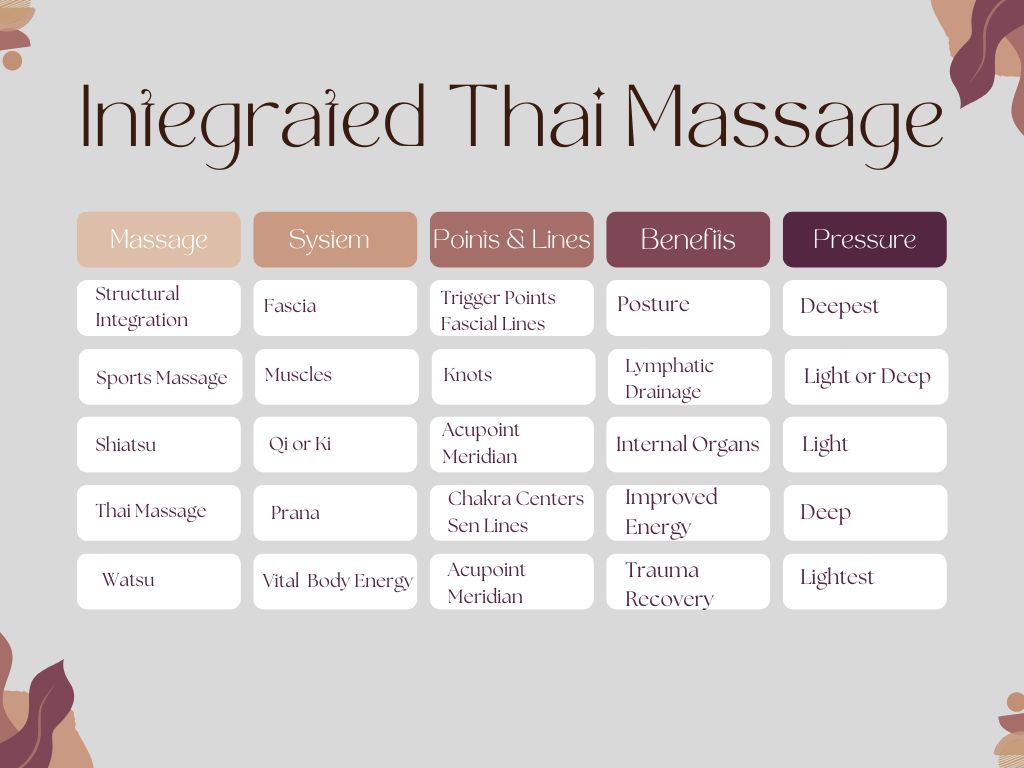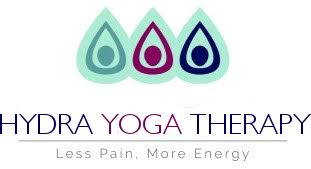
Massage Treatments
Integrated Thai Massage
Integrated Thai Massage combines both Thai and Deep Tissue to benefit clients the most without requiring them to schedule separate appointments. Traditional Thai Massage, with its deep compressions, Acupressure points and dynamic stretching, is known for releasing the body from head to foot in less than an hour. Through Thai Reflexology, the body’s aches and pains connect to internal organ energy. Although Thai Massage is an impressive modality, it is still limiting in terms of being able to get into the muscle tissue and relieve knots. Trigger Point, Myofascial, Structural Integration and Russian Sports massage are integrated to provide Medical Massage relief. Russian Sports massage is crucial in helping the range of the massage go from the lightest touch of sweeping lymphatic strokes and pressure point to deepest pain relief massage.
About the styles blended into a Customized Integrated Thai Massage:
Thai Massage
History: Traditional Thai Massage, or Naud Boratrn, “ancient healing way”, is only one branch of the many branches of Traditional Thai Medicine. While there is no definitive right way to give a Thai Massage, styles branch into; the slower gentler Northern, the pressure point focused Southern and what’s often called Royal Thai Massage which means it’s blended with oil.
The history of Thai Massage can be mapped with the spread of Bhuddism across the orient over 2500 years ago. Central to the art of Thai Massage is bodhicitta, prevalent in Thai Buddhism, called Theravada. The Thai Massage Practicioner cultivates Bodhicitta, ‘the mind of enlightenment’. Bodhicitta can be unpacked as three concepts; a strong feeling of loving good will, altruism in the sense that everyone is on an even plane and non judgement. When trying to heal someone judgement can cloud the process and block the energy from flowing.
Application: A Thai Massage is normally 60 or 90 minutes and focuses on the front or the back within a session. Traditionally the massage begins with the receiver face up, lying on a low-lying large comfortable floor mat. Being closer to the floor allows the practitioner to apply more of their body’s pressure and allows the pracitioner to climb up on the the mat with greater grace. Traditionally the massage begins with a foot massage. The foot both holds and reflects the energy of the whole body. By beginning with a foot massage the practitioner can both work to release the energy of the body as a whole and use the foot as a diagnostic tool as to what parts of the body need the most attention.
The techniques used when giving a Thai massage begin with palm pressure. Palm pressure is an amazing tool that loosens deep into the body much less painfully than other western techniques. Knees and feet are often uses as well to provide deep pressure less painfully. Most of the massage consists of thumb pressure which trace the energy lines through the body to release them. Yoga like stretches are held to pry the body apart and back into ergonomic posture. Rocking us used before a stretch or before a new segment of the massage to make sure the muscles are fully relaxed before stretching. Through rocking one can see where the body is still stiff because that area will not sway with the movement.
Steamed herbal poultices can be added for an amazing experience during Traditional Thai Massage. Heat relieves pain by increasing bloodflow and camphor and eucalyptus relieve pain, clear congestion and aid Aromatherapy applications. Poultices are applied hot! Be honest with your massage therapist for your preference of heat and let them know right away if they feel too hot on the body.
Benefits: Thai Massage is especially quick and effective at pain relief, improved flexibility, range of motion, due to the use of palm pressure and yoga stretches. Like most massages it reduces stress and improves circulation. Due to the use of pressure points which connect the sacred energy channels of the body improved sleep,
Shiatsu
History: Shiatsu evolved from Chinese Acupressure systems, meaning finger pressure. It’s first documention dates to 1320 but gained popularity in the 17th century through acupuncturist Sugiyama Waichi. Sugiyama associated Shiatsu with the blind. A blind therapist is considered to have an magnified sense of touch with which they can feel the energy points, the energy either tonified or lacking in tone. Unlike other protocoled massages, where the therapist counts the massage strokes on each body part, a Shiatsu therapist is encouraged to use enhanced perception to feel the physical and energetic blocks under their fingers.
Application: Thai Massage traditionally starts at the feet where as Shiastu starts at the head. In this way it attempts to keep the nervous system perfectly soothed the entire treatment. A perfectly soothed nervous system keep the body limp to recieve similar manipulations as Thai Massage. Finger, plam, knees and feet pressure combined with facilitated yoga-like stretching.
Benefits:
Menstrual problems
Headaches
Fibromyalgia
Structural Integration and Rolfing
Rolfing is a type of bodywork that involves deep manipulation of the body’s connective tissues. It is based on the theory that the body’s connective tissues, called fascia, can become restricted and dysfunctional over time, leading to pain, poor posture, and other health problems. Rolfing aims to realign the body’s connective tissues and restore balance and harmony to the body.
Rolfing was developed by Ida Rolf in the early 1950s. Rolf believed that the body is a system of interconnected parts, and that the way we hold our bodies can have a profound impact on our health and well-being. She developed a series of 10 sessions that are designed to help the body realign itself and regain its natural balance.
Each Rolfing session focuses on a different area of the body. The practitioner uses deep pressure to release tension in the fascia and to help the body move more freely. Rolfing can be a painful process, but it is also said to be very effective in relieving pain and improving posture.
Myofascial Massage
Myofascial massage is a gentle but deep massage technique. The therapist uses their hands to apply sustained pressure to the fascia, often using a slow, rhythmic motion. The therapist may also use a variety of other techniques, such as stretching, compression, and vibration. Gentle brother of structural integration. Manipulates the webbing of the facia using the practitioners fingertips
Russian Sports Massage
Russian sports massage is a type of massage therapy that originated in the former Soviet Union. It is a deep tissue massage that uses long, sweeping strokes to release tension in the muscles and improve range of motion. Russian sports massage is often used by athletes to help them recover from injuries and improve their performance.
Russian sports massage is characterized by its use of long, sweeping strokes that are applied with a lot of pressure. The therapist will often use their knuckles or forearms to apply the pressure, and they may also use vibration techniques. The goal of Russian sports massage is to break up scar tissue and adhesions in the muscles, which can improve range of motion and reduce pain.
Reflexology
Reflexology is a complementary and alternative medicine (CAM) therapy that involves applying pressure to specific points on the feet, hands, or ears. These points are believed to correspond to organs and other parts of the body. The goal of reflexology is to improve the flow of energy through the body and to promote overall health and well-being.
The history of reflexology is complex and there is no single founder. However, there is evidence that reflexology-like practices have been used for centuries in different cultures around the world. For example, there are references to foot massage in ancient Egyptian texts dating back to 2330 BC.
In the 19th century, a physician named William Fitzgerald developed a system of zones that he believed corresponded to different parts of the body. He called this system zone therapy. In the early 20th century, Eunice Ingham, a nurse and physiotherapist, developed a more detailed map of the feet and hands and began to practice reflexology as a way to treat pain and other health problems.
Ingham’s work helped to popularize reflexology in the United States and around the world. Today, reflexology is practiced by millions of people and is considered a legitimate form of CAM therapy.
There is some scientific evidence to support the use of reflexology for certain conditions. For example, a study published in the Journal of Alternative and Complementary Medicine found that reflexology can be effective in reducing pain and improving sleep quality in people with cancer. However, more research is needed to fully understand the benefits and risks of reflexology.
If you are considering reflexology, it is important to find a qualified reflexologist who is experienced in working with your specific needs. You can find a qualified reflexologist in your area by visiting the website of the American Reflexology Association.
Here are some of the techniques used in reflexology:
- Pressure: The therapist uses their fingers, thumbs, and palms to apply pressure to specific points on the feet, hands, or ears.
- Holding: The therapist holds the client’s foot, hand, or ear in a variety of positions.
- Massage: The therapist may use a variety of massage techniques, such as effleurage, petrissage, and deep tissue massage.
Reflexology is typically done in a series of sessions, with each session lasting about 30 minutes to an hour. The number of sessions you need will depend on your individual needs.
Tantsu
Tantsu is cutting edge in its ability to both heal and relax. Tantsu was created by the founder of Watsu later in his career, Harold Dull, around 2008. Tatusu is Watsu on land, and Watsu is Shiatsu in water. The result is the practitioner holds the subject and limbs of the subject close to their body, platonically, and feels the nervous system relax and soothe. The objective is to simply hold the subject in this relaxed state for the duration of the treatment. In practice the treatment is a series of holds and breathing. This shift in perspective from “working on” the body to being hyper aware of the nervous system fosters relaxation in the deepest way, through intimacy and self-awareness.
Tantsu, like Watsu, is lauded for it’s ability to soothe PTSD symptoms, with extensive treatment studies in veterans and sexual assault survivors. When in an Integrated Thai Massage treatment not only does Tantsu have this powerful relaxation effect, but is more effective than a traditional Deep Tissue massage, and feels better, because the subject’s limb is closer to the practitioner’s body and more adjustments can be made to pin the limb into the best position to apply a Deep Tissue stroke. Traditionally however, Tantsu is a very light and gentle practice.

